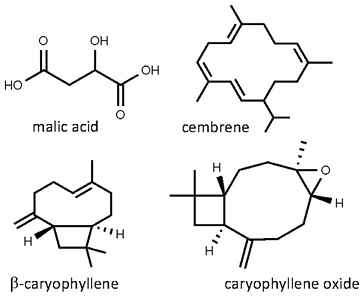 Rhus coriaria
Rhus coriaria
sumac • sumach • spice sumac
Back to “Spices: sumac (Rhus coriaria)fr”
Rhus coriaria L. (Anacardiaceae); sumak (Afrikaans); sumaq (Arabic); lan fu mu (Chinese); sumak (Dutch); corroyère, sumac des épiciers (French); Sumach, Gewürzsumach (German); soumaki (Greek); kankrasing (Hindi); sommacco (Italian); sumakku (Japanese); somagre (Persian); sumagre (Portuguese, Spanish); sumak, somak (Turkish)
DESCRIPTION Sumac or sumach is the dried pericarps of the fruits, dark red to purple-red in colour. It has a sour taste and a spicy, woody and slight citrus-like aroma.
THE PLANT A large shrub or small tree bearing large, pinnately compound leaves comprising about six pairs of dentate leaflets. The fruits are globose, velvety and up to 12 mm (ca. ½ in.) in diameter. Additional common names for the species include elm-leaved sumac, tanner’s sumac or Sicilian sumac.
ORIGIN Southern Europe.1 The plant is better known as a traditional source of dye for leather. The dried and powdered leaves were used in the tanning industry for Cordoba and Morocco leather.1 The dry fruits are an important spice in Middle Eastern cuisine but are relatively poorly known in the rest of the world.2–4 It is popular in Armenia and Turkey, North Africa (Morocco, Libya, Egypt) and practically the entire Arabian Peninsula.
CULTIVATION Trees are propagated from seeds. They grow in any deep, well-drained soil and do best in a Mediterranean climate of cool, wet winters and hot, dry summers.
HARVESTING The fruits are hand-harvested when fully ripe, dried in the sun and coarsely ground.
CULINARY USES Sumac is an important acidic spice and is usually (but not always) one of the four ingredients of the Middle Eastern spice mixture known as za’atar (za’atar herb, sesame seeds, sumac and salt – see notes on Origanum syriacum under O. vulgare). Sumac is used as a dry seasoning for vegetable dishes, salads, rice dishes, meat kebabs and meatballs. It is sprinkled on mezze dishes, rice and salads in the same way as lemon juice or vinegar, to improve the flavour. Sumac mixed with yogurt is served with kebabs.
FLAVOUR COMPOUNDS The sour taste of sumac is ascribed to malic acid4 but perhaps also the astringency of gallotannins. Dried pericarps yielded limonene, nonanal and (Z)-2-decenal as main volatile compounds in one study2 and cembrene, β-caryophyllene, β-caryophyllene alcohol, carvacrol, α-terpineol, α-pinene and farnesyl acetone in another.3. Sumac flavour has been determined to be linked mainly to the woody and spicy aromas of cembrene, β-caryophyllene and caryophyllene oxide.4 Limonene may be partly responsible for the dried lemon balm or citrus-like aroma.4

NOTES Zereshk or sereshk is the dried fruits of barberry (Berberis vulgaris), a traditional acidic Persian spice, used in much the same way as sumac. It is cooked with rice to make zereshk polo, which is eaten with chicken dishes. The berries are also used for juice, jams and fruit rolls.
1. Mabberley, D.J. 2008. Mabberley’s plant-book (3rd ed.). Cambridge University Press, Cambridge.
2. Kurucu, S., Koyuncu, M., Güvenc, A., Baser K.H.C., Özek, T. 1993. The essential oils of Rhus coriaria L. (sumac). Journal of Essential Oil Research 5: 481–486.
3. Brunke, E.-J., Hammerschmidt, F.-J., Schmaus, G., Akgül, A. 1993. The essential oil of Rhus coriaria L. fruits. Flavour and Fragrance Journal 8: 209–214.
4. Bahar, B., Altug, T. 2009. Flavour characterization of sumach (Rhus coriaria L.) by means of GC/MS and sensory flavour profile analysis techniques. International Journal of Food Properties 12: 379−387.